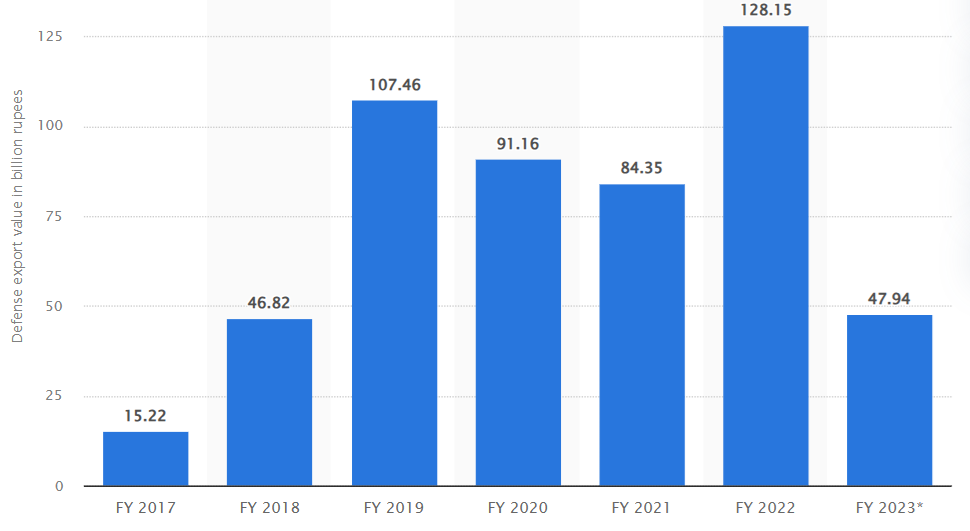
India is ramping up its defence production amid rising defence spending by East European and West Asian countries. India’s defence expenditure is expected to grow at an annual rate of 12%, reaching $147 billion between 2025 and 2029, says a report by Axis Capital Research. The government’s focus on import substitution, indigenisation, and export growth has significantly propelled the defence industry, leading to a 15% compound annual growth rate (CAGR) in the turnover of India’s defence industry.
Domestic defence manufacturing capacity, along with a more liberal export regulatory framework and a whole-of-government approach (WGA), has helped New Delhi carve a niche in global defence exports. Factors like local procurement, liberalised FDI norms, R&D support, and time-bound import embargoes have further enhanced indigenisation.
READ | Rise in diabetes cases: A healthcare crisis or pharmaceutical conspiracy
India’s defence industry
In a recent speech, Prime Minister Narendra Modi emphasised India’s capability not only in meeting its defence requirements but also in supplying to friends and allies. In the fiscal year 2022-23, India’s defence exports hit a record high of nearly Rs 16,000 crore, as reported by the defence ministry. The successful development of indigenous systems like BrahMos missiles and Akash air defence systems, which have been sold to friendly nations, marks a significant stride for a country traditionally known as a major arms importer.
Defence exports from India (FY2017-23)

Private companies are leading in defence exports, which have grown from Rs 1,500 crore in financial year 17 to Rs 15,900 crore in FY23. The proportion of defence production turnover has increased from 2% in FY17 to 15% in FY23. India looks to achieve Rs 35,000 crore defence exports by FY26.
According to the defence ministry, there has been a 23-fold increase in exports, and Indian design and development capabilities are now reaching over 85 countries. The country is actively seeking new markets in friendly nations and aims to establish long-lasting relationships in military hardware. Indian defence firms are increasingly competing with global firms in various markets, including Southeast Asia and Africa.
In Asia alone, defence spending has risen by 10% over the past decade, driven by economic growth, territorial disputes, and political tensions. Globally, defence spending has averaged 2.3% of GDP over the last 25 years. The Axis Capital report suggests that ongoing geopolitical conflicts will influence defence spending and trade relationships. India currently has 16 defence public sector undertakings, with seven listed, accounting for over 70% of the country’s defence production.
In 2023, India has the forth largest defence budget at $72.6 billion, behind the United States ($877 billion), China ($292 billion), and Russia ($86.4 billion). Worldwide, the defence spending by all countries stood at $2240 billion, with the US, Russia, France, China, Germany, and Italy collectively responsible for 80% of defence spending. Asia and Oceania accounted for 70% of imports.
Despite improved defence spending, India remains a leading global arms importer, not featuring in the top 20 arms exporters. Data from the Stockholm Peace Research Institute (SIPRI) shows that India’s share of global arms imports was 13% between 2013-17 and 11% between 2018-22.
The Indian defence industry has traditionally been dominated by public sector entities. However, complexities within the private sector have led to a reliance on arms imports. The public sector needs reforms in productivity, innovation, and international sales, especially as the government increasingly prioritises private sector involvement in defence manufacturing and innovation. Private sector firms are expected to receive defence contracts worth Rs 60,000 crore in FY 2024-2025, making up about 22% of the industry’s overall size, according to an ICRA report.
India is better positioned than ever for indigenous arms production and boasts a growing defence budget. While it has the financial capacity to support a relatively autonomous defence industrial base, the future will reveal how effectively India uses its purchasing power to develop a credible arms industry.
Despite the strides made in recent years, India’s defence industry still faces a number of challenges. These include a fragmented market with a large number of small and medium-sized enterprises, lack of coordination between the public and private sectors, shortage of skilled labour, and stringent regulatory requirements.
To overcome these challenges, India will need to improve its procurement processes, invest in research and development, and foster greater collaboration between the public and private sectors. The government will also need to play a more active role in promoting exports and developing India’s defence industrial base.
India’s growing defence budget and capabilities have not gone unnoticed by the global defence industry. Major global arms manufacturers are increasingly looking to India as a potential market for their products. This presents India with an opportunity to forge partnerships with foreign companies and acquire cutting-edge technology.
India’s defence industry has the potential to become a major global player. However, to achieve this, the country will need to address the challenges it faces and adopt a more holistic approach to defence manufacturing. This includes developing a clear industrial policy, fostering greater collaboration between the public and private sectors, and investing in research and development.
With the right policies and investments, India’s defence industry can play a key role in the country’s economic growth and security. The industry has the potential to create jobs, attract foreign investment, and enhance India’s technological capabilities. With careful planning and execution, India can become a self-sufficient defence producer and a major exporter of defence equipment.
